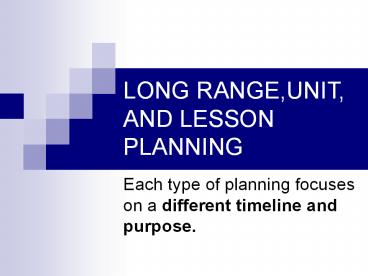LONG RANGE,UNIT, AND LESSON PLANNING - PowerPoint PPT Presentation
Title:
LONG RANGE,UNIT, AND LESSON PLANNING
Description:
LONG RANGE,UNIT, AND LESSON PLANNING Each type of planning focuses on a different timeline and purpose. All 3 types of planning are critical to effective instruction. – PowerPoint PPT presentation
Number of Views:166
Avg rating:3.0/5.0
Title: LONG RANGE,UNIT, AND LESSON PLANNING
1
LONG RANGE,UNIT, AND LESSON PLANNING
- Each type of planning focuses on a different
timeline and purpose.
2
- All 3 types of planning are critical to effective
instruction. - The Education Act requires that Long Range Plans
be available in the school office for parent
viewing upon request ( usually required by
September 30th of the current school year). - During the Performance Appraisal Cycle, or when
concerns about performance arise, administrators
will ask to see unit and lesson plans. - Be sure to include your E.A. in your plan for the
day.
3
LONG TERM PLANNING
- Sometimes referred to as Long Range or Course
Planning. - Shows an overview of the course, or integrated
courses, for the full year. - Helps you to determine and book resources,
volunteers, excursions, etc. - Keeps you moving ahead!
4
UNIT PLANNING
- More detailed than a Long Range Plan
- Starts with the ends in mind.first identify how
you will have students demonstrate their learning
(called backward design). - Includes Overall Expectations, Specific
Expectations, Assessment Strategies, Resources,
and Instructional Strategies. - Is flexible.plans are just a guideline!
5
Teach to Kids!
- Natural shift during your career
- Adjust plans as you go along to reflect needs and
interests. - Use unit plans as a guide, not a bible.
- Reflect on plans and add to them after finishing,
or while working in, each unit. - Share with colleagues! Plan together!
6
LESSON PLANS
- Provide day by day detailed plans about each of
your lessons. - Evolve in style as you gain experience and
confidence (e.g., from several pages to several
words). - Include time for mini-lessons as needed
throughout the day. - Start with the end in mindconsider first how you
will ask students to demonstrate their learning
and move ahead with plans once that is decided.
7
LESSON PLANS
- Should include
- - an introduction, hook, or mental set
- - a clear indication of the learning
expectations ( stated in an age appropriate way) - - body of the lesson (input, modeling
and demonstration, guided practice followed by
independent practice) - - a conclusion or closing
8
LESSON PLANS
- Should always be guided by the PHASES OF
INSTRUCTION - MOTIVATION
- NEW LEARNING
- CONSOLIDATION
- APPLICATION
9
LESSON PLANS
- MOTIVATION
- - 3 to 5 minutes
- - create interest
- - connect this lesson to past
- learning
- - be clear about what students will
- know or be able to do at the end
- of this lesson, and why that has
value
10
LESSON PLANS
- NEW LEARNING
- - model, model , model
- - review throughout the lesson,
- constantly cycling back to ensure
- new concepts and ideas are clear
- - ensure that everyone is involved
- - keep the lesson input as short and
- brisk as possible
- - involve as many senses as possible
- - keep ACTIVE LEARNING in mind as you
- progress through the lesson design
your input to appeal - various types of learners (i.e.,
auditory, visual, kinesthetic, etc)
11
CONSOLIDATION
- This is time to practice the new learning in
near contexts. - You scaffold the learning during this time.
- Monitor closelythe more time students spend
practising doing something the wrong way, the
more time you will spend un-teaching and
re-teaching. - Provide several closely monitored opportunities
for this type of practice. - Make anecdotal notes about progress and needs as
you supervise. - Use this time to teach mini-lessons to
individuals or small groups who didnt grasp the
new learning during your first lesson.
12
APPLICATION
- Keep in mind that the learning hasnt happened
until the student can use it independently. - Provide structured time to practise the new
learning in far contexts. - Gradually release responsibility for
learningscaffold from a more removed position. - Provide a wide variety of contexts for use of the
new skill. - Involve students in assessing the extent of their
learning. - This part of the lesson (or sequence of lessons)
should take the most time. - Include remediate and enrichment applications.
13
APPLICATION
- Keep in mind that learning is, and should be,
hard work - So, if you find yourself working harder than you
feel your students areits time to re-evaluate
your approach.
14
TIMELINE FOR PHASES OF INSTRUCTION
- Time needed will vary depending on the complexity
of the expectation. - Motivation and New Learning should take a
relatively short amount of time - - 10-20 minutes in Primary grades
- - 20-30 minutes in Junior grades
15
TIMELINE FOR PHASES OF INSTRUCTION
- CONSOLIDATION and APPLICATION phases should take
up the majority of time in a lesson or series of
related lessons - Your role changes from teller/shower to
- guide/assessor as the phases of instruction
progress.































